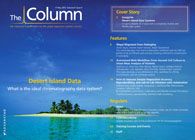Ice age appetite
An international team of scientists led by Dr Oliver Craig, University of York (York, UK) has published evidence for the consumption of fish by hunter-gatherers in the last ice age in the journal Nature.1
An international team of scientists led by Dr Oliver Craig,University of York (York, UK) has published evidence for theconsumption of fish by hunter-gatherers in the last ice age in thejournal Nature.1
The team performed gas chromatography–mass spectrometry(GC–MS) analysis on pottery dating back to the last ice age. Incharred deposits found on the pottery, high levels of compoundsderived from freshwater and aquatic organisms were found.
It is assumed humans began to make ceramic pots with thedevelopment of farming. Craig, an archeological scientist andtrained biochemist, who has worked on the analysis of organicresidues of pottery for over 15 years told The Column that hewas initially interested in finding out how hunter-gatherers usedpottery globally to pinpoint the reasons for the development.
According to Craig, the low level of organic molecules presentin the specimens was challenging. The group treated carbonizedfood deposits with acid and methanol, which increased recoveryof lipids and resulted in acid catalyzed methylation of fatty acidsaiding GC analysis with low sample loss.
Craig said: “We have discovered that foragers first used potteryas a revolutionary new strategy for the processing of aquaticresources and that this fundamental technology emerged in aperiod of rapid climate change. In particular, the sophisticationof pottery-using hunter-gatherers at the end of the last ice agestrongly challenges the popular perception of this period.”
Reference
1. O.E Craig, Nature, DOI: 10.1038/nature12109 (2013).
This story originally appeared in The Column. Click here to view that issue.

Regulatory Deadlines and Supply Chain Challenges Take Center Stage in Nitrosamine Discussion
April 10th 2025During an LCGC International peer exchange, Aloka Srinivasan, Mayank Bhanti, and Amber Burch discussed the regulatory deadlines and supply chain challenges that come with nitrosamine analysis.












